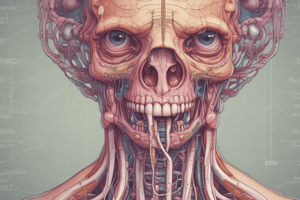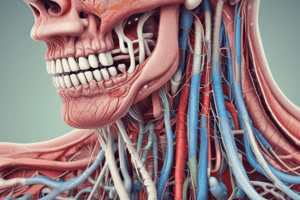Podcast
Questions and Answers
What are the primary functions of the parotid salivary glands?
What are the primary functions of the parotid salivary glands?
- Secretes hormones
- Produces taste sensations
- Controls the release of bile
- Secretes saliva to aid in digestion (correct)
What is the role of the submandibular salivary glands?
What is the role of the submandibular salivary glands?
Control the release of saliva into the area of the mouth located just under the tongue.
What do the sublingual salivary glands produce?
What do the sublingual salivary glands produce?
Mucin and saliva.
Where does food enter the digestive system?
Where does food enter the digestive system?
What is the pharynx's function?
What is the pharynx's function?
What role does the glottis play?
What role does the glottis play?
What is the function of the epiglottis?
What is the function of the epiglottis?
What does the esophagus do?
What does the esophagus do?
What is the stomach's primary function?
What is the stomach's primary function?
What are rugae?
What are rugae?
What do the gastric pits in the stomach do?
What do the gastric pits in the stomach do?
What is the small intestine's function?
What is the small intestine's function?
What does the duodenum do?
What does the duodenum do?
What is the primary function of the large intestine?
What is the primary function of the large intestine?
What role does the pancreas play in digestion?
What role does the pancreas play in digestion?
What is the function of bile?
What is the function of bile?
_____ is an enzyme that breaks down proteins.
_____ is an enzyme that breaks down proteins.
The main components of mucus are gel-forming _____ secreted by goblet cells.
The main components of mucus are gel-forming _____ secreted by goblet cells.
What is the unique structure of goblet cells?
What is the unique structure of goblet cells?
Match the following salivary glands to their primary functions:
Match the following salivary glands to their primary functions:
Flashcards are hidden until you start studying
Study Notes
Salivary Glands
- Parotid Salivary Glands: Largest salivary glands, located around the mandibular ramus. Secrete saliva via Stensen duct to aid in digestion.
- Submandibular Salivary Glands: Control saliva release under the tongue, significant for taste and digestion.
- Sublingual Salivary Glands: Produce mucin to promote saliva production, enhancing lubrication during swallowing.
Digestive Tract Overview
- Mouth: Entry point for food, beginning the digestion process.
- Pharynx: Passageway for food, liquids, and air to the esophagus.
- Esophagus: Transports food and liquids from mouth to stomach.
- Stomach: Serves as a container initiating digestion and regulating food discharge into the intestines.
Stomach Structure and Function
- Rugae: Folds that allow the stomach to expand when full; assist in mixing food.
- Gastroesophageal Sphincter: Controls entry and exit of substances into and out of the stomach.
- Pyloric Sphincter: Regulates exit of chyme into the duodenum from the stomach.
Small Intestine Components
- Small Intestine: Site of 90% food digestion and nutrient absorption, consisting of duodenum, jejunum, and ileum.
- Duodenum: First and shortest segment, vital for chemical digestion of chyme.
- Jejunum: Specialized for absorption of digested nutrients.
- Ileum: Absorbs vitamin B12, bile salts, and remaining nutrients.
Large Intestine Components
- Large Intestine: Absorbs water, stores waste as feces, consists of cecum, colon segments, sigmoid colon, and rectum.
- Cecum: Acts as a storage area; in humans, it has limited use compared to herbivores.
- Descending Colon: Stores feces, absorbs water and nutrients, prepares for elimination.
Accessory Organs
- Pancreas: Produces digestive enzymes and hormones like insulin and glucagon.
- Liver: Filters blood, processes nutrients, and detoxifies harmful substances.
- Gallbladder: Stores and concentrates bile; involved in digestion of fats.
Digestive Enzymes
- Amylase: Breaks down carbohydrates.
- Lipase: Breaks down lipids.
- Trypsin: Breaks down proteins.
Movement and Absorption
- Peristalsis: Wave-like muscle contractions moving substances through the GI tract.
- Segmentation: Mixing movement mainly in the small intestine, enhances nutrient absorption.
Tissue Types in Digestive Tract
- Simple Columnar Epithelium: Found in intestines and stomach; increases surface area for absorption.
- Stratified Squamous Epithelium: Found in the esophagus; serves as a protective barrier.
Specialized Structures
- Goblet Cells: Secrete mucus to lubricate the digestive tract and protect epithelial cells.
- Bile: Emulsifies fats, increasing surface area for enzyme action.
Additional Concepts
- Mesenteries: Support and anchor portions of the intestine.
- Enzymes and Catalysts: Enzymes are proteins that accelerate chemical reactions; catalysts increase reaction rates without becoming part of the product.
- Hydrolases: Enzymes that catalyze the hydrolysis of chemical bonds, important in digestion.
Environmental Effects on Enzymes
- Temperature and pH: Affect enzyme activity; low temperatures slow reactions and high temperatures may destabilize enzymes, altering their effectiveness.
Studying That Suits You
Use AI to generate personalized quizzes and flashcards to suit your learning preferences.




